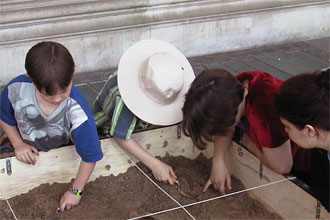About the ASP Project

Project structure
Five regional 'triads' each consisting of an ITT provider, a partnership school and a linked museum have been established. These are:
- University of Cambridge Faculty of Education & Milton Road Primary School partnered with the Fitzwilliam Museum;
- Pilgrim Partnership & Castle Lower School partnered with the Cecil Higgins Art Gallery and Bedford Museum;
- UEA & Long Stratton High School partnered with Norwich Castle Museum;
- University of Herts & St Michaels School partnered with Verulamium Museum;
- University of Beds & Russell Lower School with Museums Luton.
What's involved
This idea is not new. Well documented case-studies by colleagues around the country can be found on the 'Teaching Outside the Classroom' website (www.teachingoutsidetheclassroom.com). We hope the variety of approaches being trialled during this pilot project will add a body of new evidence that will be useful to colleagues from both sectors. Trainee teachers join the education team of their linked museum for blocks of time during their normal school-based placement. The schools are fully involved in the implementation of this training experience. Prior to the placements being undertaken, close liaison will have taken place between the ITE institutions, the schools and the museum to ensure that the learning opportunities offered to the trainees fits with the wider requirements of the training course.
Addressing the Standards for QTS
The underpinning philosophy of this initiative is that the trainee teachers involved are developing a broader understanding of teaching per se; this is not simply about finding out what museum educators do. It has been especially interesting as the project has progressed to see just how many of the particular aspects of the standards by which the trainees are assessed can be met in the 'alternative setting' of the museum.
Preparing the ground: Professional development
All the project participants first worked together establishing a shared philosophy, aims and objectives and agreed working methods. Then the five triads independently designed training programmes to meet the specific and different needs of all involved in each grouping. During this developmental phase training and dissemination events were provided for all colleagues:
- museum education training for ITT colleagues to inspire tutors from both generic 'professional studies' routes and subject-specific curriculum areas;
- museum education training and cascading events run in colleges of education to extend tutor involvement within each ITT provider;
- presentations in colleges of education modelling successful practice and encouraging ITT providers to consider placements within museums;
- training for teachers from the partnership schools to raise awareness of the value of, and methods involved in museum education;
- training for museum education professionals held in colleges of education introducing the structures of ITT, the demands of the new standards leading to QTS and the demands of mentoring.
Preparing the ground: Trainee teacher induction
Each triad has developed detailed placement plans all of which demonstrate clear progression. Following one or two induction days, the trainees undertake structured, supported observations of museum teaching. They research the wider 'learning' remit of the museum and build an understanding of the particular approaches that museum educators use to engage and inspire pupils.
Progression
As the placement progresses, trainees become increasingly involved in teaching; working with groups and finally leading sections of teaching sessions. As they do this they must meet the many the challenges of teaching unfamiliar children. Each trainee keeps some record of their experience, whether it be the formal Record of Professional Development required by the ITE provider or a more personalised reflective learning journal. In either case, this lends structure to their own learning which will inform their day-to-day practice in school.
